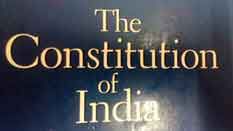Indian Constitution: Key Features, Strengths, Weaknesses, Influence of other Constitutions Over It, Its Influence Over Other Constitutions and Evaluation
The Indian Constitution is a constantly evolving and extensive legal text that
acts as the highest form of law in India, providing a structure for the nation's
administration and outlining the responsibilities, obligations, and authority of
its people and organizations. It embodies concepts of democracy, secularism,
socialism, and justice, and creates a federal system that prioritizes
fundamental rights, an independent judiciary, parliamentary democracy, and a
combination of guiding principles that shape state policies, reflecting the
varied hopes and principles of Indian culture.
Key Features:
The Indian Constitution, which was adopted on January 26, 1950, is recognized for its extensive scope, depth, and adaptability, reflecting the diverse social and cultural landscape of India.
The following are the key features of the Constitution:
Together, these features make the Indian Constitution an extraordinary document, serving as the backbone of India's democratic and secular governance. It is a testament to the country's commitment to upholding the values of democracy, equality, and justice for all its citizens.
Strengths:
The adaptability, resilience, and inclusivity of the Indian Constitution are its greatest assets. Designed to cater to the intricate needs of a nation with diverse cultures and beliefs, it offers a sturdy structure for democratic administration, safeguarding essential freedoms, advocating for social fairness, and upholding the principles of justice. Its pliability permits necessary modifications to tackle emerging obstacles while upholding the fundamental values of democracy, secularism, and parity, thereby fostering a sense of harmony amid differences and propelling Indian society towards a fairer and more prosperous tomorrow.
Weaknesses:
The complexity and length of the Indian Constitution is a notable drawback, causing potential delays in both justice and governance. Its extensive provisions, combined with intricate legal interpretations, can create loopholes and uncertainties, leading to difficulties in implementation and enforcement. Despite its progressive ideals, certain outdated colonial-era laws and bureaucratic inefficiencies still exist, impeding the prompt delivery of justice and efficient governance. Finding a middle ground between upholding constitutional principles and streamlining legal processes remains a persistent issue, requiring constant reforms to address these weaknesses and establish a more effective and fair system.
Influence of Other Constitutions on Indian Constitution:
Indian Constitution is enriched by incorporating significant features from the Government of India Act, 1935. These include a federal scheme that outlines the distribution of powers between the Centre and states, the establishment of the role of governor to promote effective state-level administration, the framework for an independent judicial system that upholds justice and the rule of law, the establishment of Public Service Commissions to ensure merit-based recruitment in public offices, and provisions for emergency situations that contribute to the strength and functionality of India's constitutional democracy.
It also incorporates features inspired by Australia. These include the Concurrent List, which promotes cooperative federalism and allows for the coexistence of central and state legislative powers. Additionally, our Constitution embraces Australia's emphasis on freedom of trade, commerce, and intercourse for economic liberty.
From Canada, it inherits the federal structure with a strong central authority. This includes vesting residuary powers in the Centre to maintain administrative clarity. It also adopts Canada's model of centrally appointing state governors to ensure administrative cohesion.
Elements from Ireland are also incorporated, such as the inclusion of Directive Principles of State Policy, which guide governance towards social justice. It also borrows the method of presidential election from Ireland.
From Japan, it adopts the concept of Procedure Established by law, which ensures legal validity and due process in legislative procedures.
It adopts the concept of Fundamental Duties from the USSR, promoting civic responsibility among citizens. The ideals of social, economic, and political justice, outlined in the Preamble, are also embraced.
From the UK, it adopts principles of parliamentary government, rule of law, and legislative procedure, as well as features like single citizenship, cabinet system, prerogative writs, parliamentary privileges, and bicameralism, which are the foundation of India's democratic governance.
The Constitution also draws from the US, guaranteeing fundamental rights, preamble, independence of the judiciary, judicial review, impeachment procedures for the president, and the establishment of the post of vice-president.
Additionally, it incorporates elements from Germany's Weimar Constitution, including provisions for the suspension of Fundamental Rights during emergencies, in order to strike a balance between individual liberties and national security.
The Indian Constitution incorporates elements from South Africa, specifically in its approach to making changes to the constitution, guaranteeing a well-organized and thoughtful process for altering its fundamental document, as well as in the manner of selecting representatives for the Rajya Sabha, the upper house of Parliament.
Furthermore, it adopts the idea of a republic from France and embraces the notions of freedom, equality, and brotherhood stated in its Preamble, demonstrating a dedication to principles of equality and democracy.
Influence of Indian Constitution on Other Constitutions:
In the post-colonial era, numerous countries have looked to the Indian Constitution for inspiration. This influence is evident in Nepal's 2015 constitution, which includes provisions on fundamental rights and federalism that closely resemble those in India's framework. Similarly, Bangladesh's 1972 constitution, created after gaining independence from Pakistan, reflects India's prioritization of parliamentary democracy and fundamental rights.
South Africa's 1996 constitution, following the end of apartheid, also draws from the Indian Constitution in its emphasis on human rights. Fiji's 2013 constitution is another example of Indian influence, particularly in its sections on parliamentary democracy and minority rights. However, the Indian Constitution's impact extends beyond these well-known instances to numerous other nations, particularly former colonies and those with shared historical and cultural backgrounds.
Evaluation:
The Indian Constitution is an outstanding accomplishment in democratic governance, representing the hopes and variety of its citizens. Its robustness can be seen in its all-encompassing structure, safeguarding essential rights, advocating for fairness, and nurturing a lively democracy. Nevertheless, it also encounters obstacles due to its intricacy, bureaucratic drawbacks, and the requirement for continuous adjustments to address changing social and political circumstances.
Despite these imperfections, its endurance and flexibility have allowed India to successfully navigate through numerous obstacles while upholding its democratic principles, making it a model for constitutionalism worldwide.
Written By: Md.Imran Wahab, IPS, IGP, Provisioning, West Bengal
Email: [email protected], Ph no: 9836576565
Key Features:
The Indian Constitution, which was adopted on January 26, 1950, is recognized for its extensive scope, depth, and adaptability, reflecting the diverse social and cultural landscape of India.
The following are the key features of the Constitution:
-
Preamble: The Constitution commences with a Preamble that delineates the principles and aspirations of the Indian people, including justice, secularism, liberty, equality, and fraternity, which serve as the guiding principles for the governance of the nation.
-
Federal Structure with Unitary Features: India has a federal structure where powers are divided between the central government and the states. However, during times of emergency, the Constitution allows for a strong unitary system, giving the central government overriding authority.
-
Fundamental Rights: The Constitution guarantees fundamental rights to its citizens, such as the right to equality, freedom of speech and expression, the right to life and personal liberty, and the freedom of religion, among others. These rights are justiciable,
enabling citizens to enforce them through the courts.
-
Directive Principles of State Policy: The Constitution includes Directive Principles of State Policy, which provide directives for the government to promote social and economic justice, protect the environment, advance education, and strive towards a welfare state.
-
Parliamentary System: India follows a parliamentary form of government where the President is the ceremonial head of state, and the true executive power is vested in the Prime Minister and the Council of Ministers, who are accountable to the Lok Sabha (lower house of Parliament).
-
Independent Judiciary: The Constitution establishes an independent judiciary with the Supreme Court as the highest judicial body. It serves as the guardian of the Constitution, safeguarding the rights and liberties of citizens and upholding the rule of law.
-
Separation of Powers: The separation of powers is a fundamental aspect of the Constitution, ensuring a balance of power among the executive, legislative, and judicial branches of government to prevent any one branch from gaining too much control. This system of checks and balances is crucial in maintaining a stable government.
-
Universal Adult Franchise: In order to uphold the principles of democracy, India has adopted universal adult suffrage, granting every citizen above the age of 18 the right to vote without any discrimination based on caste, creed, religion, or gender. This has made India one of the largest democracies in the world.
-
Emergency Provisions: To address emergency situations, the Constitution includes provisions for three types of emergencies - national emergency, state emergency (President's Rule), and financial emergency. These provisions give the central government the power to take necessary and extraordinary measures in times of crisis.
- Amendment Procedure: While the Constitution is a living document, it also has a rigid aspect. It can be amended, but the process is not simple. Certain provisions require a special majority of both houses of Parliament, while some amendments also require ratification by a majority of state legislatures. This ensures that any changes to the Constitution are carefully considered and not made lightly.
Together, these features make the Indian Constitution an extraordinary document, serving as the backbone of India's democratic and secular governance. It is a testament to the country's commitment to upholding the values of democracy, equality, and justice for all its citizens.
Strengths:
The adaptability, resilience, and inclusivity of the Indian Constitution are its greatest assets. Designed to cater to the intricate needs of a nation with diverse cultures and beliefs, it offers a sturdy structure for democratic administration, safeguarding essential freedoms, advocating for social fairness, and upholding the principles of justice. Its pliability permits necessary modifications to tackle emerging obstacles while upholding the fundamental values of democracy, secularism, and parity, thereby fostering a sense of harmony amid differences and propelling Indian society towards a fairer and more prosperous tomorrow.
Weaknesses:
The complexity and length of the Indian Constitution is a notable drawback, causing potential delays in both justice and governance. Its extensive provisions, combined with intricate legal interpretations, can create loopholes and uncertainties, leading to difficulties in implementation and enforcement. Despite its progressive ideals, certain outdated colonial-era laws and bureaucratic inefficiencies still exist, impeding the prompt delivery of justice and efficient governance. Finding a middle ground between upholding constitutional principles and streamlining legal processes remains a persistent issue, requiring constant reforms to address these weaknesses and establish a more effective and fair system.
Influence of Other Constitutions on Indian Constitution:
Indian Constitution is enriched by incorporating significant features from the Government of India Act, 1935. These include a federal scheme that outlines the distribution of powers between the Centre and states, the establishment of the role of governor to promote effective state-level administration, the framework for an independent judicial system that upholds justice and the rule of law, the establishment of Public Service Commissions to ensure merit-based recruitment in public offices, and provisions for emergency situations that contribute to the strength and functionality of India's constitutional democracy.
It also incorporates features inspired by Australia. These include the Concurrent List, which promotes cooperative federalism and allows for the coexistence of central and state legislative powers. Additionally, our Constitution embraces Australia's emphasis on freedom of trade, commerce, and intercourse for economic liberty.
From Canada, it inherits the federal structure with a strong central authority. This includes vesting residuary powers in the Centre to maintain administrative clarity. It also adopts Canada's model of centrally appointing state governors to ensure administrative cohesion.
Elements from Ireland are also incorporated, such as the inclusion of Directive Principles of State Policy, which guide governance towards social justice. It also borrows the method of presidential election from Ireland.
From Japan, it adopts the concept of Procedure Established by law, which ensures legal validity and due process in legislative procedures.
It adopts the concept of Fundamental Duties from the USSR, promoting civic responsibility among citizens. The ideals of social, economic, and political justice, outlined in the Preamble, are also embraced.
From the UK, it adopts principles of parliamentary government, rule of law, and legislative procedure, as well as features like single citizenship, cabinet system, prerogative writs, parliamentary privileges, and bicameralism, which are the foundation of India's democratic governance.
The Constitution also draws from the US, guaranteeing fundamental rights, preamble, independence of the judiciary, judicial review, impeachment procedures for the president, and the establishment of the post of vice-president.
Additionally, it incorporates elements from Germany's Weimar Constitution, including provisions for the suspension of Fundamental Rights during emergencies, in order to strike a balance between individual liberties and national security.
The Indian Constitution incorporates elements from South Africa, specifically in its approach to making changes to the constitution, guaranteeing a well-organized and thoughtful process for altering its fundamental document, as well as in the manner of selecting representatives for the Rajya Sabha, the upper house of Parliament.
Furthermore, it adopts the idea of a republic from France and embraces the notions of freedom, equality, and brotherhood stated in its Preamble, demonstrating a dedication to principles of equality and democracy.
Influence of Indian Constitution on Other Constitutions:
In the post-colonial era, numerous countries have looked to the Indian Constitution for inspiration. This influence is evident in Nepal's 2015 constitution, which includes provisions on fundamental rights and federalism that closely resemble those in India's framework. Similarly, Bangladesh's 1972 constitution, created after gaining independence from Pakistan, reflects India's prioritization of parliamentary democracy and fundamental rights.
South Africa's 1996 constitution, following the end of apartheid, also draws from the Indian Constitution in its emphasis on human rights. Fiji's 2013 constitution is another example of Indian influence, particularly in its sections on parliamentary democracy and minority rights. However, the Indian Constitution's impact extends beyond these well-known instances to numerous other nations, particularly former colonies and those with shared historical and cultural backgrounds.
Evaluation:
The Indian Constitution is an outstanding accomplishment in democratic governance, representing the hopes and variety of its citizens. Its robustness can be seen in its all-encompassing structure, safeguarding essential rights, advocating for fairness, and nurturing a lively democracy. Nevertheless, it also encounters obstacles due to its intricacy, bureaucratic drawbacks, and the requirement for continuous adjustments to address changing social and political circumstances.
Despite these imperfections, its endurance and flexibility have allowed India to successfully navigate through numerous obstacles while upholding its democratic principles, making it a model for constitutionalism worldwide.
Written By: Md.Imran Wahab, IPS, IGP, Provisioning, West Bengal
Email: [email protected], Ph no: 9836576565
Law Article in India
Legal Question & Answers
Lawyers in India - Search By City
LawArticles
How To File For Mutual Divorce In Delhi

How To File For Mutual Divorce In Delhi Mutual Consent Divorce is the Simplest Way to Obtain a D...
Increased Age For Girls Marriage

It is hoped that the Prohibition of Child Marriage (Amendment) Bill, 2021, which intends to inc...
Facade of Social Media

One may very easily get absorbed in the lives of others as one scrolls through a Facebook news ...
Section 482 CrPc - Quashing Of FIR: Guid...

The Inherent power under Section 482 in The Code Of Criminal Procedure, 1973 (37th Chapter of t...
The Uniform Civil Code (UCC) in India: A...

The Uniform Civil Code (UCC) is a concept that proposes the unification of personal laws across...
Role Of Artificial Intelligence In Legal...

Artificial intelligence (AI) is revolutionizing various sectors of the economy, and the legal i...








Please Drop Your Comments